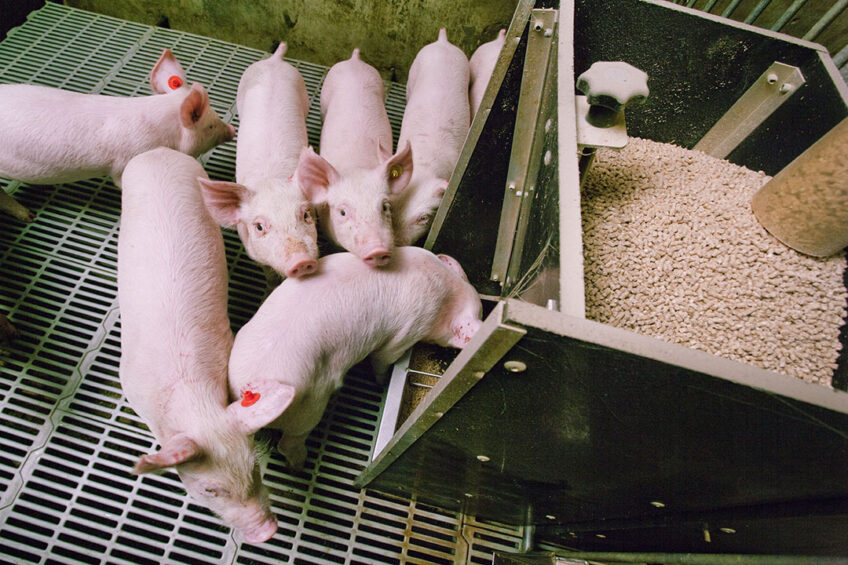Can you influence intestinal microbiota with feed?

In humans, there are 1000 different bacteria found in the digestive tract alone. Every person and animal has their own unique ‘microbial fingerprint’. Diet can have a major impact on the microbiota composition. It can also be used as a mean of intervention to modulate gut microbiota.
Domestic animals harbour a densely populated microbial community consisting of bacteria, viruses, and fungi that live on external and internal surfaces, especially on the mucous membranes of the oral cavity and the intestine. The mammalian gastrointestinal tract is estimated to contain several hundred to a thousand different species of bacteria that constantly interact with the host and further members of its microbial community.
Intestinal microbiota
Microbiota is the term used to describe the assemblage of microorganisms present in a defined environment. The microbial community living in the gut is referred to as the intestinal microbiota. The study of microbiota is carried out by molecular methods based mainly on the analysis of marker genes, such as the 16S rRNA gene, that are amplified and sequenced from specific biological samples and taxonomically assigned at different levels from phylum to species. Microbiota plays a critical role in a several physiological, neurological and immunological functions; provide important benefits to its mammalian host such as the digestion of otherwise indigestible parts of the feed, the production of volatile fatty acids or vitamins and the re-cycling of bile salts. However, this microbial population also includes potentially disease-causing bacteria such as Escherichia coli, Lawsonia intracellularis, Salmonella, and some bacterial species of the genus Clostridium.
Calorie storage
Normally, the availability of calories for metabolic processes is not limited and the excess nutrients are stored in adipose tissue. This calorie storage depot as well as some muscle protein locations can achieve states of higher biological importance as first responders to be catabolised to yield energy and amino acids for immune defence purposes, especially in the face of reduced voluntary feed intake. This means that a maximum utilisation of nutrients for the growth of young pigs is only possible if a general state of health is ensured, in which any unnecessary activation of the immune system is avoided. Accordingly, the reduction in growth rates is not only a consequence of reduced feed intake in response to infection, but also the result of altered digestive and metabolic processes and activation of the immune system. Depending on the enteric pathogen, infection can induce several pathophysiologic mechanisms that cause diarrhoea in pigs: hypersecretion, malabsorption, inflammation and/or increased intestinal permeability. In the case of digestive bacterial infections, a reduction in the average growth rate of pigs is particularly high and amount to up to 40% in total (associated and not associated with a reduction in feed intake).
Microbiota and gut health
In a “healthy gut”, the different bacterial species are in balance and regulate each other. This balance also protects against colonisation by such pathogens, which is why the microbiota also play a significant role in resistance to colonisation (ability to limit the pathogen load within the host) and tolerance to colonisation (ability to limit the damage caused by a particular pathogen after infection). If the balance is disturbed, the microbiota itself can become harmful or may lose its host-protective function. A resilient animal with a resilient microbiota can better compensate such disturbances. A resilient microbiota could therefore be used as surrogate for healthy microbiota and maintaining resilient microbiota may be important for health.
Diet as a means of intervention
External factors including disease, stress, or major changes in diet could be seen as disturbances. Remarkably, diet is considered to be one of, if not, the most important factor affecting the intestinal microbiota. At the same time, diet can be one possible mean of intervention. Knowledge of the characteristics of a resilient microbiota to specific infectious diseases is a prerequisite to design interventions aimed at increasing resilience. Currently, dietary fibres in particular are the subject of research on resistance and tolerance to intestinal pathogens in pigs and other farm animals. Such carbohydrate polymers are not digested nor absorbed in the small intestine and reach the large intestine where they are subjected to bacterial fermentation. Dietary fibres impact the composition and function of the microbiota, especially the production of short chain fatty acids, and increase microbiota diversity. Current, in scientific literature, a diverse intestinal microbial community, besides resilience, stability and resistance (to minor changes) is considered healthy.
Boosting bacteria with nutrition
Other strategies comprise of dietary interventions to boost certain microbial species. Bacterial species that are commonly perturbed due to various challenges could be boosted or replenished by nutritional intervention, e.g. by administration of the bacterium as a probiotic. However, not all challenge-diminished species exist as probiotics. Instead, ingredients known to boost those species may also be used to prevent their decline during and after a pathogenic challenge. For example, Faecalibacterium prausnitzii is considered as a beneficial intestinal commensal that is thought to be a functionally important member of the microbiota and probably has an impact on host physiology and health. Its prevalence is often decreased in conditions of intestinal dysbiosis.
A recent study showed that in comparison to a wheat-based diet, a rye-based diet promoted the growth of Bifidobacterium, several lactic acid bacteria and Faecalibacterium prausnitzii in caecal content of pigs experimentally infected with Salmonella Typhimurium. At the same time, the intestinal load of Salmonella Typhimurium was lower in pigs fed the diet with a high proportion of rye.
This article is a summary of presentation that was given at Eurotier 2022 during a Pig Progress seminar: The diet as opportunity to influence intestinal microbiota to improve “Gut health”.







